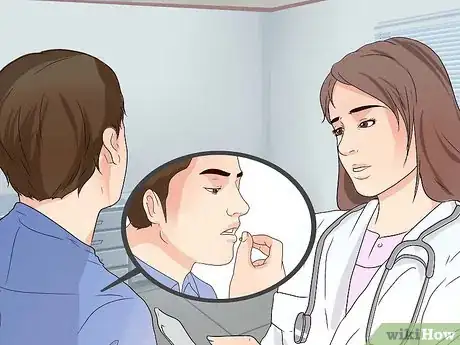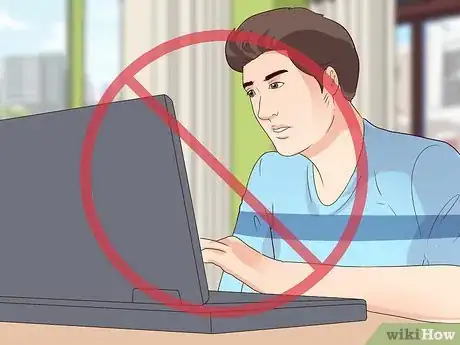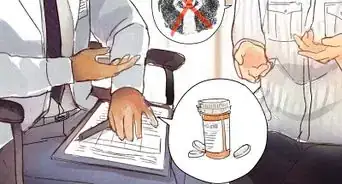This article was co-authored by Tasha Rube, LMSW. Tasha Rube is a Licensed Social Worker based in Kansas City, Kansas. Tasha is affiliated with the Dwight D. Eisenhower VA Medical Center in Leavenworth, Kansas. She received her Masters of Social Work (MSW) from the University of Missouri in 2014.
There are 13 references cited in this article, which can be found at the bottom of the page.
This article has been viewed 114,639 times.
Illness anxiety disorder (IAD) is the currently accepted medical term for what used to be called hypochondriasis. [1] A study from 2001 found that between 5 and 9% of primary care patients exhibited symptoms of IAD. [2] People with IAD can have mild or no symptoms whatsoever, yet still believe themselves to have a serious or life-threatening illness. [3] This fear is persistent and interferes with their everyday lives. Visits to a healthcare provider and diagnostic tests may demonstrate that there is no disease, but this does not alleviate the anxiety a person with IAD feels. [4] Alternatively, people with IAD may actually have a disease, but have a strong belief that they are sicker than they truly are. [5] Although people with IAD are unable to accurately assess the feelings and symptoms in their own bodies, there are ways to overcome IAD.
Steps
Building a Support System
-
1Get a medical evaluation with your primary care provider. Make a list of your current symptoms to take with you to the appointment. Since IAD can be associated with having been ill as a child or other traumatic events, make sure to inform your healthcare provider about your medical history. [6] Your primary care provider may refer you to a mental health professional for additional treatment.
-
2Locate a healthcare provider you can trust. Obviously, the most difficult part of being a hypochondriac is that you constantly feel as if there is something terribly wrong with your body. Ultimately, a trained physician is the only person who can diagnose your symptoms and monitor them for any changes that could require a medical intervention. If you aren’t in regular contact with a doctor, finding one should be your first step.Advertisement
-
3Create a good relationship with your physician. If you suffer from hypochondriasis, it’s likely you’re going to be getting to know your doctor quite well. When you have an appointment, don’t be afraid to ask questions and get as much information as you can.
- Be honest about what you're feeling and how you perceive your symptoms, even if you feel embarrassed.
- Give your physician as detailed a medical history as you can. Your doctor needs as much information as possible to offer an accurate diagnosis.
- Keep an open mind. There may be times when you think certain medical tests are necessary, and your doctor will disagree.
- There may also be times when your doctor will feel that you do not trust their judgment, and you may feel as if your doctor isn’t taking you seriously.
- If this happens, try to remember that your physician is trying to help you, even though you differ in the perception of your situation.
- Follow the treatment plan, including taking all prescribed medications. If you don't, your doctor cannot accurately evaluate if the plan is working for you.
-
4Consider joining a support group. It’s common to feel alone in your illness. Your doctor says you’re not really sick, your therapist is teaching you that you can’t trust your own perceptions of body sensation, and you’re starting to wonder how it’s possible that you’ve been so wrong. Add it up, and it can be very overwhelming.
- If you’ve never met someone with your condition, it can be profoundly validating to talk to someone who has suffered from the same sorts of fears and intrusive thoughts.
- Group therapy can introduce you to people who have learned to thrive with your condition, as well as people who are just starting out in treatment.
- Your group can provide you a support system for the times when you begin to waver in your treatment and start to doubt whether you want to continue.
- If you stick with your group, you can even eventually start giving back by helping others who are struggling.
- The internet is filled with message boards and forums for anxiety disorders where you can connect with and share feelings with others with IAD.
-
5Talk with a trusted friend. It can be embarrassing to admit that you are consumed by obsessive fears over your health. You don’t want to be someone who is constantly complaining to everyone about how you’re sure you have a terminal illness. Unfortunately, isolating yourself only makes things worse.
- Many of the worst symptoms of IAD emerge while you’re alone and your brain starts spiraling into “what if?” questions, but your relationships can help you stay grounded.
- Friends are no substitute for treatment, but anything that helps you break up that avalanche of worries before it overwhelms you is a positive resource.
- A close friend might be able to see patterns in your life that you don’t, like that your symptoms escalated after the death of a loved one or the loss of a job.[7]
Changing the Way You Think About Your Illness
-
1
-
2Be prepared for feelings of resistance. If you’re convinced that you have a serious medical issue, you may find it insulting to sit and talk with someone who is telling you that you aren’t capable of accurately perceiving your own body. But if you want to overcome the fear and anxiety that is causing you so much emotional turmoil, you need to trust someone who understands your condition.
- Your doctor may ask you to stop monitoring your physical symptoms. This may cause you some anxiety, but allow yourself to feel uncomfortable.
-
3Test the validity of your fears. Much of your treatment will hinge on challenging your thinking. You might be asked to stop taking your blood pressure or feeling for lumps on your body, and your therapist will push you to examine the fears that underlie your worries about your health. You must resist the temptation to fall back into a pattern of obsessive self-monitoring.
- Remind yourself that this uneasiness is evidence that the process is working and that you're making progress.
- You're not going to get better without making some significant changes, and the change process is always going to be difficult on some level.
-
4Discover what triggers your anxiety. [10] In some cases, anxiety actually creates physical symptoms such as stomach distress, so part of your counseling will involve learning about what makes you particularly vulnerable to being overcome with worry about your health.
- You may feel more anxiety over perceived symptoms during times of stress in life.
- Working with a therapist will teach you to identify the signs so that you can stop those negative thoughts before they consume you.
- Attend all of your scheduled treatment sessions, even if you aren't feeling well or aren't sure it's making a difference. If you don’t take your treatment seriously, it won’t work.
-
5Educate yourself about your condition. While hypochondriasis is less well researched than many mental illnesses, there is a body of research available if you do a little digging.
- There are numerous blogs and forums where people relate the stories of how they came to understand their illness and learned to manage it.
- Reading these stories will help you identify many of the same thoughts and fears in your own life.
- Channel your anxiety into better understanding your disorder. Use the time you would have spent researching symptoms to read up on hypochondriasis.
-
6Keep a journal. Writing down your thoughts will provide you with a record of your symptoms and experiences. If your symptoms repeatedly lead to nowhere, you will be able to provide yourself evidence that your fears have been unfounded all along.
- When you're feeling anxious or wish you had someone to talk to, write down your thoughts instead.
- Think about where your feelings originated. Are you terrified of experiencing physical pain? Have you watched someone close to you suffer with an illness?
- Exploring some of those bigger questions will help you uncover the thinking patterns that are underlying your anxiety. [11]
- Writing down your thoughts will allow you to track your symptoms and triggers.
- For instance, do you worry more when you're stressed at work or arguing with your partner? Once you can identify those triggers, you can start to manage them more effectively.
Changing the Way You Feel
-
1Ask your doctor if a medication could help you. Research indicates that hypochondriasis is correlated with depression and anxiety disorders[12] , which suggests that there could be a genetic origin. In that case, you may need to try an antidepressant prescription to fully treat your issues. If that ends up being the case, don’t resist that treatment.
- According to research, serotonin reuptake inhibitors (SSRIs) and tricyclic antidepressants are the most commonly prescribed medications for hypochondriasis. Generally speaking, these drugs are not considered dangerous or physically habit-forming.
- As with most mental illnesses, a combination of medication and cognitive-behavioral therapy is the most effective course of treatment for hypochondriasis.
- It’s possible that you won't make sustained progress if you don’t take your treatment seriously, so stay with your therapy and medication even if you feel better.
-
2Make changes to your diet. Though research into the connection between diet and hypochondria is in its infancy, a few general guidelines are recommended.
- Eliminate all foods that you suspect you're sensitive to. Any food that causes you bodily distress will potentially produce symptoms that you could easily misinterpret.
- Additionally, eating smaller meals throughout the day will stabilize your blood sugar and help with digestion, thereby improving your mood and helping to reduce pains.
- Cut back on caffeine. Stimulants can worsen anxiety, and it’s difficult to control racing thoughts and sleeplessness if you’ve had two cups of coffee before bed.[13]
-
3Try doing yoga or exercise. Any vigorous physical activity will release endorphins – the “feel good” chemicals in your brain – and give you a natural high. Additionally, if you tire out your body, you’ll be more relaxed and less likely to stay up until 4:00 a.m. doing web searches for proof that the sounds in your stomach mean that you have cancer.
- Work out for at least 30 minutes a day, five days a week.
- If you currently have no exercise routine, feel free to start out small with 15 to 20 minutes of walking per day.
- To help manage anxiety, the frequency of your workouts is more important than the duration, so spread your sessions throughout the week.[14]
-
4Sleep on a regular schedule. Because excessive worry and anxiety often lead to difficulties sleeping, it’s common for those with hypochondriasis to fall into patterns where they don’t get a sufficient amount of rest every night. When that happens, you’re likely to be tired and cranky, making it harder to think clearly and fight against the sorts of thoughts that have caused your problems in the first place. [15]
- Use relaxation techniques before going to bed, like gradually tensing and releasing all of your muscle groups, one at a time.
- You also might be the kind of person who deals with anxiety by taking a warm bath or listening to some calming music.
- Go to bed at the same time every night and avoid napping late in the day, even if you're tired. Over time, you'll feel more rested and balanced.
- Any small disruptions in your sleeping patterns can make it difficult to get back on track, so do what you can to stick to your routine every day.[16]
-
5Avoid web searches for disease symptoms and illnesses. Searching for the cause of your perceived symptoms will only exacerbate your condition. Avoid using the web for this purpose, and instead fill your time with other healthy activities.
Warnings
- Although people with IAD often misinterpret minor symptoms, things like chest pain, trouble breathing, bleeding, severe sudden pain, or visibly broken bones should always be evaluated by a healthcare professional.⧼thumbs_response⧽
References
- ↑ https://my.clevelandclinic.org/services/neurological_institute/center-for-behavorial-health/disease-conditions/hic-hypochondriasis
- ↑ http://www.ncbi.nlm.nih.gov/pubmed/11416938
- ↑ https://my.clevelandclinic.org/services/neurological_institute/center-for-behavorial-health/disease-conditions/hic-hypochondriasis
- ↑ https://my.clevelandclinic.org/services/neurological_institute/center-for-behavorial-health/disease-conditions/hic-hypochondriasis
- ↑ https://my.clevelandclinic.org/services/neurological_institute/center-for-behavorial-health/disease-conditions/hic-hypochondriasis
- ↑ http://www.mayoclinic.org/diseases-conditions/illness-anxiety-disorder/basics/preparing-for-your-appointment/con-20124064
- ↑ http://www.ncbi.nlm.nih.gov/pubmed/2861797
- ↑ http://www.ncbi.nlm.nih.gov/pubmed/17943915
- ↑ http://www.nbcc.org/counselorfind
- ↑ http://www.nhs.uk/conditions/hypochondria/Pages/Introduction.aspx
- ↑ http://www.calmclinic.com/treatment/hypochondria
- ↑ http://www.nhs.uk/conditions/hypochondria/Pages/Introduction.aspx
- ↑ http://www.nhs.uk/Conditions/Anxiety/Pages/self-help.aspx
- ↑ http://www.adaa.org/living-with-anxiety/managing-anxiety/exercise-stress-and-anxiety
- ↑ http://www.calmclinic.com/treatment/hypochondria
- ↑ http://www.mayoclinic.org/healthy-lifestyle/adult-health/in-depth/sleep/art-20048379
- ↑ http://www.adaa.org/understanding-anxiety/related-illnesses/substance-abuse
About This Article
If you struggle with illness anxiety disorder, get a checkup from your healthcare provider to evaluate your health and help put your mind at ease. To ensure that you feel your health concerns are being taken seriously, look for a supportive and reputable doctor in your area. Be honest with your doctor and give them detailed information about your symptoms, health history, and any concerns you may have. If you need extra support, look into joining a support group for people who also deal with illness anxiety disorder. Your doctor or therapist may be able to recommend a group. Don’t hesitate to reach out to friends and loved ones or a professional counselor about what you’re going through, as well. Scroll down for more advice, including how to change the way you think and feel about your condition.














































































Medical Disclaimer
The content of this article is not intended to be a substitute for professional medical advice, examination, diagnosis, or treatment. You should always contact your doctor or other qualified healthcare professional before starting, changing, or stopping any kind of health treatment.
Read More...